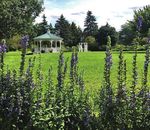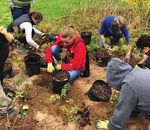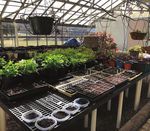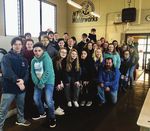The North Tonawanda Sustainable Community Program - A Visionary Partnership
←
→
Page content transcription
If your browser does not render page correctly, please read the page content below
Red lobelia, hibiscus and blue flag irises thrive in the stormwater
wetland at the North Tonawanda Botanical Garden. Laura Pecoraro
The North Tonawanda Sustainable Community Program –
A Visionary Partnership
by Robbyn Drake, David Conti and Laura Pecoraro
T
he city of North Tonawanda, New York, is a community It was no accident that water quality became a central theme
embraced by fresh water. The sweeping arc of the Erie of the NTBGO. The organization’s all-volunteer board is led by
Canal, here a stretch of native Tonawanda Creek, borders Chair David Conti, chief operator of the City of North Tonawanda
the city to the east and south. The sun sets in the west Water Treatment Plant. With 14 years of experience operating
over the majestic Niagara River, the connecting channel for lakes both wastewater and water treatment plants, David recognizes the
Erie and Ontario and a stunning stretch of fast, clean Great Lakes importance of preserving our clean source water as well as educat-
water. This community is defined by life on the water: fishing, ing the public about water quality and recruiting young people to
swimming, boating and paddling form the foundations of good careers in water infrastructure. Local teachers were already bring-
living for residents and visitors alike. This love of water has given ing their students to visit the water treatment plant and learn from
rise to a unique partnership to preserve water quality and engage David. An idea was born for an innovative partnership that could
young people in creating a cleaner future for their city. continued on page 54
The North Tonawanda Botanical Garden
Our story begins at an 11-acre botanical garden in disrepair
along the Erie Canal. The garden was a local fixture in the
1960s and 1970s but fell victim to budget cuts as maintenance
requirements outstripped the city’s budget for staffing and
repairs. In 2016, a small group of residents took charge of the
garden and began to reimagine what it could be to their com-
munity. Envisioning a low-maintenance, ecologically sustainable
facility featuring native plants, pollinator gardens, cutting-edge
green infrastructure and environmental education opportunities,
group leaders founded the 501(c)(3) nonprofit North Tonawanda
Botanical Garden Organization, Inc. NTBGO leaders recognized
the enormous potential to grow the botanical garden into an
educational hub for exploring the ecological links between native
plants, pollinators and birds; for piloting green infrastructure
practices such as rain gardens, rain barrels and stormwater
wetlands to keep our water clean; and for modeling sustainable
gardening to inspire a lifetime of environmental stewardship.
NTBGO strives to exhibit sustainability in practice, programs and Volunteers donate their time to work on restoring a reclaimed garden
future plans for infrastructure. bed at the botanical garden. Laura Pecoraro
Clear Waters Winter 2020 53continued from page 53
link educational visits to the water treatment plant, hands-on
experiences establishing green infrastructure at the botanical
garden, and field trips to explore water quality and green infra-
structure in other areas of the city.
Sustainable Community Program
Collaborating with a local grant writer, NTBGO leaders devel-
oped the details and budget for the new North Tonawanda
Sustainable Community Program. Economic need, documented
by city and U.S. Census Bureau data, qualifies parts of North
Tonawanda as a New York State Department of Environmental
Conservation (NYSDEC) Environmental Justice Area. As a com-
munity-based organization in an Environmental Justice Area,
NTBGO is uniquely situated to collaborate with local educational,
municipal and private sector partners to engage young people
and adults in environmental stewardship projects and to invest
city residents in local environmental health. In addition, because
North Tonawanda’s history includes heavy industrialization of the
Niagara River shoreline, land and water contamination are real
health and safety concerns. These factors made the new North Students from North Tonawanda High School tour the North Tonawanda
Tonawanda Sustainable Community Program a top candidate for Water Treatment Plant in February 2020. Laura Pecoraro
Students from the North Tonawanda Middle School plant native North Tonawanda High School students help with potting plants
Monarda and Liatris in the stormwater wetland in October 2020. at the botanical garden’s greenhouse in February 2020 for planting
Laura Pecoraro in the spring. Laura Pecoraro
the NYSDEC’s Environmental Justice Community Grant. NTBGO designated Environmental Justice Area of North Tonawanda.
was awarded the three-year grant in 2019 and is currently carrying Chief Operator David Conti maintains contact with local educa-
out the project. tors and partners in the Sustainable Community Program and
North Tonawanda middle and high school students participat- schedules tours of the plant. When students tour the water treat-
ing in the Sustainable Community Program learn how to plant ment plant, they experience the process of cleaning and disinfect-
and sustain native habitats and engage in best practices for water ing the water delivered to the community. They see firsthand how
quality stewardship in their community. They conduct water test- our city treats and uses water and addresses water quality issues
ing and collect data for water monitoring research. They study such as stormwater runoff. Water plant operators provide these
native habitats created by NTBGO within the botanical garden guided tours and engage students in conversations about choosing
and have planted hundreds of native plants to attract native a career in the water industry.
pollinators for habitat and hosting, to mitigate stormwater and The 2020 pandemic has brought changes in the way the Water
to beautify the landscape. Students engage in creating and main- Treatment Plant, NTBGO and our other partners can access and
taining green infrastructure to protect water quality, both at the interact with teachers and students, but it has not stopped our
botanical garden and at other sites within the city. These real-life programs. Visits to the water treatment plant were limited to very
experiences make environmental stewardship come alive for stu- small groups, with masking and social distance requirements in
dents in a way that is difficult to achieve in the classroom. place. Instead of collecting 120 middle school students for one
The Water Treatment Plant is located within the state- annual field day event, we began holding small group events to
54 Clear Waters Winter 2020Blue lobelia in the stormwater wetland frame a picturesque gazebo in Perennials wait in a holding area before planting in their final location
the North Tonawanda Botanical Garden. Laura Pecoraro in the botanical garden. Laura Pecoraro
supplemental irrigation. The 5,000-square-foot stormwater wet-
land on the site is in constant bloom from May through October.
Favorite pollinators flock to the chosen plants and have increased
biodiversity within the gardens. Many new species of butterflies,
bees and birds are identified each year. As natives plant species
grow, stormwater ponding has decreased.
Each spring, NTBGO volunteers select and grow all the plants
used in the garden projects on-site. Plants are selected for criteria
such as deer resistance, pest and disease resistance, moisture and
exposure requirements and attraction of pollinators.
Another partnership underway at the botanical garden is
a Living Shoreline Restoration Project sponsored by Buffalo
Niagara Waterkeeper. Part of the Tonawanda Creek shoreline and
an acre of the park itself will be restored to a riparian buffer zone,
which will feature native plant habitat for shoreline and wetland
creatures. Paths and educational signage throughout this area will
educate visitors about the importance of riparian buffers along
with native plant and animal species. This project is already being
incorporated into Sustainable Community Program educational
Plants for the botanical garden projects are germinated and propagated sessions at the botanical garden with students of all ages.
in the greenhouses on the property. Laura Pecoraro Future plans include buildout of a site master plan and develop-
ment of an education center, featuring Leadership in Energy and
make sure students still enjoyed a live educational experience. Environmental Design (LEED) certification and green infrastruc-
Water sampling kits were provided to middle school students ture. The master plan design was created as a semester project by
attending a weekend event at NTBGO. Each individual experi- the University of Buffalo’s Sustainable Futures Studio, and the
enced sampling and recorded data. College and middle school education center plans were received through a design contest
students stayed outdoors in small groups and engaged in exciting this year. A green infrastructure training program for profession-
initiatives such as planting native species in stormwater wetlands als is also in development. Partners are seeking grant funding to
or collecting seeds for propagation at a native tree nursery at the begin these projects. Students engaging in successive years of the
wastewater treatment plant. The City of North Tonawanda Youth Sustainable Community Program will be able to see these changes
Center has been an invaluable partner in reaching out to par- as they unfold in real time.
ents and students that may be interested in participating in the The municipality and NTBGO are working hand in hand to
Sustainable Community Program. engage residents in hands-on projects that help solve tough envi-
ronmental problems in their own community. The momentum
A Bright Future Ahead and excitement generated through the high school and middle
The North Tonawanda Botanical Garden has thrived under its school programs has already inspired a small student volunteer
new use as a community teaching tool. NTBGO plans sustainable base for NTBGO. The synergy between the Water Treatment
gardens for locations topographically suited to plants’ moisture Plant, NTBGO and city leadership has built a strong base of
requirements, carefully selecting plants that will flourish without continued on page 57
Clear Waters Winter 2020 55continued from page 55
community collaboration and engagement. We look forward to a
bright future for our city as we grow opportunities for residents to
learn and practice environmental stewardship and sustainability.
Robbyn Drake, the lead author of this article, is an independent consul-
tant to local environmental organizations, offering organizational capac-
ity building, project management, grant writing, community outreach
and educational program development services. Robbyn is the project
manager for the North Tonawanda Botanical Garden Organization’s
Sustainable Community Program and can be reached at robbyndrake@
gmail.com. David Conti is the chair of the North Tonawanda Botanical
Garden Organization, Inc., as well as the chief operator of the Water
Treatment Plant and a licensed wastewater treatment plant operator. His
knowledge of water quality issues and solutions provides guidance for the
programming provided by NTBGO to students, citizens and visitors to
North Tonawanda. David can be reached at dconti@northtonawanda.
org. Laura Pecoraro is a founding member of the North Tonawanda
Botanical Garden Organization, Inc. and serves as secretary for the
organization. Her interest in returning native plants to any landscape
that she can inspired her to create the pollinator garden for the North
Tonawanda Botanical Garden. Please contact her with any questions at
ntbgo@hotmail.com. The plants in the pollinator garden are selected and arranged to attract
pollinating insects with the promise of nectar and shelter. Laura Pecoraro
2021 Upcoming Training Classes & NYWEA Meetings
March 3-4, 2021 Effective Utility Management Workshop
Virtual via Zoom
March 9, 2021 Green Infrastructure Webinar Series / Part 1 of 2
Virtual via Zoom
March 11, 2021 Green Infrastructure Webinar Series / Part 2 of 2
Virtual via Zoom
April 6, 2021 Activated Sludge Fundamentals Webinar Series / Part 1 of 2
Virtual via Zoom
April 8, 2021 Activated Sludge Fundamentals Webinar Series / Part 2 of 2
Virtual via Zoom
April 27, 2021 Biological Media Lunch & Learn Webinar
Virtual via Zoom
April 29, 2021 Turbo Blower Technology for the Next Decade Webinar
Virtual via Zoom
May 4, 2021 Process Modeling as a Tool in Operating WRRFs Webinar
Virtual via Zoom
May 6, 2021 UV and Ozone Disinfection Webinar
Virtual via Zoom
May 11, 2021 Biosolids Drying Lunch & Learn Webinar / Part 1 of 2
Virtual via Zoom
For more
May 13, 2021 Biosolids Drying Lunch & Learn Webinar / Part 2 of 2
classes, Virtual via Zoom
information & May 25, 2021 NYSDEC: Net DMR/DMR Submission Webinar
registration, Virtual via Zoom
visit June 7-9, 2021 2021 Spring Technical Conference & Exhibition
nywea.org. Syracuse, NY
Clear Waters Winter 2020 57You can also read


























































